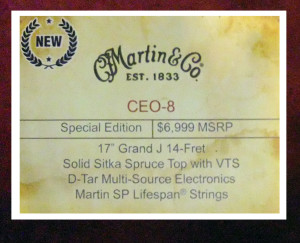Decorative and decked out, the CEO-8 is the latest in a series of acoustic guitars designed by Chief Executive Officer Chris Martin
aka C.F. Martin IV
Specs include: All solid wood construction; Grand Jumbo body size; sycamore back and sides; Vintage Tone System torrefied Sitka spruce top; 5/16″ Sitka spruce bracing with progressively scalloped tone bars unique to the Grand J size; sycamore neck with dovetail neck joint, modified low oval profile and Performing Artist taper, 1-3/4″ at nut, 2-1/8″ at 12th fret; 2-3/16″ string spacing; modified 30’s style bridge with drop-in Tusq saddle to go with the D-TAR Multi-Source pickup system; bone nut; high gloss finish with Cheery Burst unique to the CEO-8 tinting on the top, back, sides, and neck; abalone rosette; large mother of pearl block fretboard markers; wide crested headstock with retro gold tuning machines and large pearloid keystone buttons
Note: this model was changed to have a traditional Martin logo on the headstock. So if you got one with the slanted logo, your great grandchildren might just sell it for a lot money someday.
A New Classic
Facets reminiscent of various iconic guitars embellish core elements with some rarity about them, making Mr. Martin’s CEO-8 an appealing musical instrument that seems familiar yet very much its own entity.
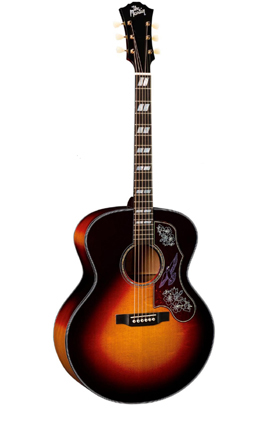 This is only the second Martin model made from sycamore, which offers tonal properties similar to other American hardwoods like maple and cherry, while not sounding exactly like either. This is also the first CEO model to use the seldom seen Grand Jumbo body size, which debuted on a 12-string in 2009 and was used again in 2011 for the company’s first baritone guitar.
This is only the second Martin model made from sycamore, which offers tonal properties similar to other American hardwoods like maple and cherry, while not sounding exactly like either. This is also the first CEO model to use the seldom seen Grand Jumbo body size, which debuted on a 12-string in 2009 and was used again in 2011 for the company’s first baritone guitar.
Whereas the J designed thirty years earlier by Chris Martin owes its silhouette to the Martin archtops of the 1930s, the Grand J was derived from the Martin C-1 archtop, which debuted in 2004. Both Jumbo bodies have a depth of 4-7/8″. But the Grand J’s 17″ lower bout is a full inch wider than the regular Jumbo, and its upper bout is almost an inch wider.
The cavernous sound chamber is ideal for amplifying the subtly distinctive tonal properties of American sycamore, which it does to very good effect. Conversely, the clarity and musicality of sycamore provides the CEO-8 with an ideal platform and framing for a Grand J voice that is more open and airy than heard from the previous 6-string Grand Jumbos – the Grand J-35, the Grand J-28LSE, and the Pete Seeger signature model – each made from Indian rosewood.
The Grand J was reputedly inspired by the Guild F-50, which first appeared circa 1954, and like Martin’s Grand J it remains a bit larger than other Guild jumbos. Those rosewood Grand Js did have a certain Guild-esque quality to their tone and dynamics, with a dense, ham-fisted punch that inspired a player to dig in with all the strength they could muster. The CEO-8 sounds and plays quite differently, from previous Grand Js and from any other Martin guitar I have encountered.
photo: C.F. Martin
VTS Sitka Spruce
There is firmness in the tone of the fundamentals, with a focused density to the trebles and effortless definition to the thicker wound strings, and a dwindling presence in the airy harmonics. As such, the CEO-8 does not take much effort to light up the room with a voluble voice of high, pretty bells backed by a warming throb from the bass.
A soundboard made from Sitka spruce adds some meat to the notes, but the bright and drier qualities of sycamore sees to it there is not a lot of fat filling out the space around them. Together they produce a voice and tonal pallet with a lean and lovely filet at its heart, rather than the denser Angus rib eye saturating the sound of most large-bodied Martins.
The Sitka used on this model has been torrefied though Martin’s VTS – Vintage Tone System. This proprietary treatment was developed to accelerate the aging process of a guitar’s soundboard, so that it behaves and sounds like a top that has broken-in through many years of seasoning. Learn more about the use of torrefaction in modern luthiery HERE.
The VTS treatment does seem to wake up a spruce top, so that it sounds more alive and open, and with a palpable 3-D tonality, than my ears expect to hear from a brand new guitar. But I also feel that Martins made with VTS Sitka spruce have an increased high end chime that sounds more like Adirondack spruce, without losing any of the warmth and meat on the bone that is the classic Sitka calling card.
With its Grand J sycamore body topped with VTS Sitka spruce, the CEO-8 has a voice with a unique character. The bottom-end boost from the extra-large sound chamber fills out the bass, while the rest of the voice stays open. Strummed chords ring out, vivid and vibrant, while arpeggios and picking patterns laydown a succession of clear strong notes that never get in each other’s way, thanks to unusual rates of sustain and decay.
The precise fundamentals and arid undertone place the emphasis on the top notes, which evaporate faster than with other bright tonewoods like mahogany and koa, leaving behind a radiating harmonic spectrum, which gathers in different registers, depending upon how hard the strings are played.
It responds well to a relaxed touch, blossoming during a lazy country blues, and it turns punchy when attacked, but retrains some depth in the voice, so it does not flatten out and rely entirely on the strings during aggressive strumming, the way some other large jumbos are prone to do.
Big Boned But Pretty With Personality
This is by far the heaviest of this year’s new Martins. Part of that comes from the on-board electronics, but mostly it is due to such a large body made from solid wood and braced to support the extra-wide top and back.
According to Tim Teel, Head of Instrument Design at C.F. Martin, they “employ a non-scalloped X brace for clarity and nice, punchy highs, along with progressively scalloped tone bars to balance the bass response on such a large body.” What is meant by progressive scalloping is that the thickest and tallest of three tone bars is near the bridge plate, each getting thinner or lower out towards the rim, where the guitar’s top meets the sides.
But the hefty build also contributes to the CEO-8’s unusual dynamics and appealing tone.
The fundamental notes leap out from the strings with a good deal of pop to them. They are quite solid, yet slender, with space between each, and between the fundamentals and the expansive harmonic tonescape humming below, around, and above them.
Each new note appears quickly, clear and separate from its neighbors. It hangs there for a moment and then recedes back into the voice, with a smoothness to the decay I find very appealing. They actually sustain a good while, but at a reduced volume that fades effortlessly through the background radiation of undertone that is sourced as much from the vibrant treble strings as from the bass.
The fundamental note from the low E string is quite lean, growing firmer the harder one picks. But it triggers a swollen dumpling of undertone that is thick yet defined, even as bass notes sustain and fall away, like something solid, sinking straight down through clear, deep water that allows them to remain distinct until they suddenly vanish from sight. This unusual containment of the deep bass makes the midrange seem wide open.
The midrange notes have the fastest decay, sounding loud and clear over a glassy abyss, and then dropping back a bit faster than the unwound treble strings. But even though the top notes off the D and G string decay at a faster rate, they are often replaced by sympathetics in the same range, which hover like ghosts and at times outlast the fading bass and treble.
As individual treble notes are played with a firm attack, they stand out, stark and defined from any reflection bouncing off the walls inside the sound chamber. But when an unwound string is played lightly, an aura of resonance swells out around it, as if slow-motion flash bulbs were flooding the tonal landscape with brilliant silvery light. But that effect is sped up when a chord is strummed, as a fleeting, chrome-plated glimmer ripples from the highest note, down through the center of the voice, leaving a clean, open wake backed by a fading hum, like the echo of a thunderclap, extended by Sitka’s relatively slow cycles of resonance.
While not as warm as mahogany, sycamore’s tonal palette has extra presence down below when compared to maple or cherry, and the Grand J size makes the most of it. The large body promotes that bottom end, which is helpful to drier, leaner tonewood, so each plunk, thunk, and nuanced picking holds its own with the punchy mids and vivacious treble.
The D-18 Sycamore model struck me as a dreadnought with a different ratio of bass to mids to treble, which might appeal to someone who wants the dread experience without so much woof under the roof. But this CEO-8 is very much a different kind of Martin, atypical yet that much more noteworthy because of it. It has an appearance, voice and dynamics that suggest some non-Martins that look similar to it. But when such comparisons are made, it becomes obvious that this clear and ringing guitar is still 100% a Martin.
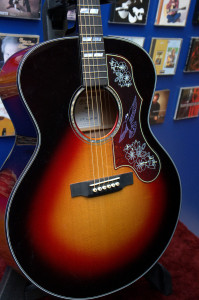 |
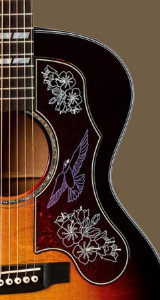 |
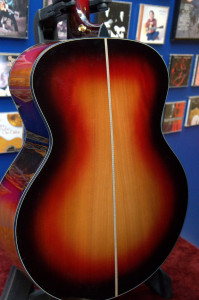 |
photos: Maury’s Music
Super Duper Appointments
Where the original Grand Js may have emulated the Guild mystique, recent entrants in the CEO series were designed to reflect Chris Martin’s longtime admiration for the classic prewar guitars built by Martin’s main competitor, Gibson. And in the CEO-8 we find Martin’s homage to the most iconic Gibson of them all, the SJ-200.
Anyone familiar with historic guitars will immediately recognize how the vintage sunburst Super Jumbo provided inspiration for the CEO-8. But some people will likely take a closer look and see how cleverly Martin has adapted the SJ styling in an overall design scheme that blends together cosmetic detailing drawn from multiple sources, including other CEO models.
Both uber jumbos offer a sunburst finish on the top, sides, back, and neck. The CEO-8 has a color pallet very much in the red end of the spectrum, fading into an orangey beige at the center of its various bursts. This gives the Martin more of a Les Paul color scheme than the autumnal browns and bronzes that brighten into golden yellow on the sunburst SJ-200.
The pearl rosette is similar to that on the 200, but the Martin 30’s-style bridge looks nothing like the flamboyant mustache splashed across the Gibson, and the multicolor marquetry used for the CEO-8 back strip is taken directly from the Martin D-45. And while the pickguard design is clearly meant to emulate the Gibson style, the CEO-8 displays a patch of flowers at each end, with a bird across the center, its wings spread in majestic flight. This may be a nod toward the dove and hummingbird sitting on the pickguard of their respective namesake Gibsons, but here the particular bird is, of course, a purple martin.
A major difference between the two designs is found in the feel of the neck, as the SJ-200 has a 12″ radius, with a rolled edge to the fingerboard and a rounded shape to its profile, compared to the traditional Martin 16″ radius and their modern modified low oval profile with the Performing Artist taper. The CEO-8 fingerboard is squared at the sound hole; the Gibson is carved into a point, while also being bound in white.
Some prewar SJ-200s have surfaced with block inlays on the fingerboard, similar to the CEO-8 markers, but none of them are cut-in-two with slashes. That is something more likely seen on Gibson electric guitars, like the wartime ES-300.
And the black faceplate on the CEO-headstock had a crown in mother of pearl on the prototype seen in the video review. Apparently a decision was made to drop that feature and the production version simply has the slanted “The Martin” is inlaid above it. This same logo was used on the CEO-6 and is a play on the classic “The Gibson” script logo of bygone years.
But if Martin really wanted to do it right, they would have left the letter i undotted, as Gibson did on those early examples of the L-5 archtop and the 12-fret Nick Lucas Special from the 1920s. Gibson actually stopped using The Gibson logo long before they followed Martin into the modern world of 14-fret flattops.
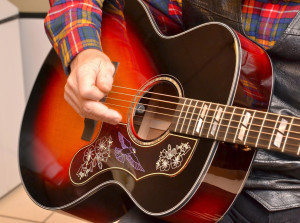 The size and shape of the headstocks are similar, with the CEO-8 having a double cascade across the top, and the exact same silhouette as the Martin C-1. But like the SJ-200, they were all based on archtop guitars from the Jazz Age.
The size and shape of the headstocks are similar, with the CEO-8 having a double cascade across the top, and the exact same silhouette as the Martin C-1. But like the SJ-200, they were all based on archtop guitars from the Jazz Age.
The Martin has a Tusq saddle, which their research has shown is the best choice for an undersaddle pickup. It can be changed out for bone or some other material easily enough. But when it comes to plugging in, the Gibson SJ-200 acoustic-electric model comes standard with a Fishman Ellipse Aura undersaddle pickup system. The CEO-8 comes with the D-TAR Multi-Source system, which combines a piezoelectric Wave-Length under-saddle pickup with a microphone seated just in front of the bridge plate and isolated by “an absorptive visco-elastic polymer shock mount.” The two sources are blended and amplified by an 18-volt preamp, that uses two AA batteries. It is the same system found in the OMC-LJ Pro, Laurence Juber Custom Artist Edition.
photo: Maury’s Music
An Attractive Alternative
When writing my review of the CEO-7, I said the slope-shouldered 00 seemed like a Golden Era series replica of a prewar Martin from an alternative history, where Martin had been borrowing from Gibson designs rather than the other way around. But just as the square-shouldered Gibsons sound little like a Martin D-28, the CEO-7 doesn’t sound much like the L-00 in whose image it was made. And the CEO-6 sounds even less like the Gibson J-45 it resembles.
In the case of this CEO-8, however, the special tonal pallet blended from the sycamore back and sides with the VTS Sitka spruce top, along with the particular dynamics inherent to the Grand Jumbo with its rotund body and heavier bracing, results in a voice and responsiveness that is indeed reminiscent of a maple Gibson SJ-200. So much so, I sought out a 200 to remind myself of its particular personality.
Both guitars are of similar weight, similar volume, and have some similar tonal properties, with precise trebles, glassy mids, and a firm edge to the bass. Both do very well for relaxed fingerpicking and gentle pick-and-strum kind of playing. Both have a pretty voice. But as expected, the CEO-8 has a thicker undertone swelling up around the fundamentals, even if it is more translucent and airy than heard from other Martins, whereas the Gibson often has fatter notes directly off the strings, but less going on around them in terms of harmonic swell.
The SJ-200 I played was a very good example, and had more midrange presence to the immediate voice and the fundamental sustain, while the CEO-8 had more sustain and undertone radiation at the top and bottom ends. And the CEO-8 responded better to heavy, sweeping strums, while the SJ-200 sort of hit a wall and flattened out, sending most of the energy into the trebles, except for that tight maple plunk in the bass, which is of course one reason so many performers play a 200 when trying to fit into the mix of a large band.
But the sycamore CEO-8 does not by any means come with the typically thick and woofy Martin undertone, except at the very bottom of the voice, where it only encroaches into the other registers here and there. It remains more of a spacious and arid experience, with quicker decay to the midrange undertone, leaving a well-lit cellar opening up behind the top notes, which themselves also have faster decay, even if it cannot match the vanishing act of a typical Gibson.
While the CEO-8 is refreshingly different in tone from other Martins, it is still satisfyingly different from its Gibson counterpart. It sounds, plays and feels less like a copy of a Gibson SJ-200, than it is an alternative to the Gibson, and to traditional Martins.
As with all the CEO guitars from C.F. Martin IV, the CEO-8 should inspire a polarized public response. For some, it will seem ostentatious if not audacious. Others will appreciate Martin’s homage to a competitor’s classic model, and the fun involved in designing such an alternate universe kind of guitar, not to mention the good-natured attempt to out-jumbo the inventor of the Super Jumbo.
Someone who loves the maple Gibson SJ-200 sound will likely not be swayed by the Martin CEO-8. But someone who wants a guitar that allows the main notes to take center stage, but still have some umph behind them, may find the CEO-8 well worth tracking down. And those who always liked the SJ-200 aesthetic, but always wished for a bit more presence and tonal complexity to come with it, should find the CEO-8 right up their sonic alley.
And that is one man’s word on…
The Martin CEO-8
List Price: $6,999.00
Ask your Martin dealer for the real price!
*See any typos, errors, or having issues leaving a comment? oneman@onemanz.com – thanks!*
Further Reading
Martin CEO-8.2 and 8.2E Review
Martin OM-28 Authentic 1931 Review
~
~
Official Spec Sheet
Model: CEO-8
Construction: Dovetail Neck Joint
Body Size: 17″ Grand J-14 Fret
Top: VTS Solid Sitka Spruce
Rosette: Two Ring – Multiple B/W Fiber w/ Select Abalone
Top Bracing Pattern: Standard “X”, Progressively Scalloped Tone Bars
Top Braces: Solid Sitka Spruce 5/16″
Back Material: Solid Sycamore
Back Purfling: Style 45
Side Material: Solid Sycamore
Endpiece: Black Boltaron
Endpiece Inlay: Black/White Boltaron
Binding: Black Boltaron
Top Inlay Style: Multiple Black/White Boltaron
Side Inlay: Multiple Black/White Boltaron
Back Inlay: Black/White Boltaron
Neck Material: Solid Sycamore
Neck Shape: Modified Low Oval w/ PA Taper
Nut Material: Bone
Headstock: Solid/Archtop Shape
Headplate: Black Corian w/ MOP (The Martin) w/ Crown Inlay
Heelcap: Black Boltaron w/ Multiple B/W Inlay
Fingerboard Material: Solid Black Ebony
Scale Length: 25.4″
Number of Frets Clear: 14
Number of Frets Total: 20
Fingerboard Width at Nut: 1-3/4″
Fingerboard Width at 12th Fret: 2-1/8″
Fingerboard Position Inlays: MOP Backslash Design
Fingerboard Binding: none
Finish Back & Sides: Polished Gloss w/ Custom Cherry Burst
Finish Top: Polished Gloss w/ Custom Cherry Burst
Finish Neck: Polished Gloss w/ Custom Cherry Burst
Bridge Material: Solid Black Ebony
Bridge Style: Modified 30’s Style w/ Drop-In Saddle
Bridge String Spacing: 2-3/16″
Saddle: 16″ Radius/Compensated/White Tusq
Tuning Machines: Gold w/ Pearloid Keystone Buttons
Recommended Strings: Martin SP Lifespan Phosphor Bronze Medium Gauge (MSP7200)
Bridge & End Pins: Bone w/ Paua Pearl Dots
Pickguard: Faux Red Tortoise w/ Purple Martin Design
Case: 593 Geib Style
Interior Label: Signed by CFM IV – Numbered in Sequence w/o Total
Electronics: D-Tar Wave-Length Multi-Source
Other Options: Available left-handed at no additional charge
